Photos by Tony Avelar
“Hey, what’s up?” Barry Roth says, offering a fist bump to a student in one of the halls at Encina Preparatory High School in Sacramento. “Are you doing all right today?”
It’s a scene that plays out over and over throughout the school day as Roth keeps a keen watch for students who might need some extra support. He spots a girl with a dour look on her face sitting outside a classroom, stopping midsentence to approach her and determine whether something is amiss. Every adult at Encina High is hyperfocused on supporting their students’ mental and emotional well-being, so they have the space they need to learn.
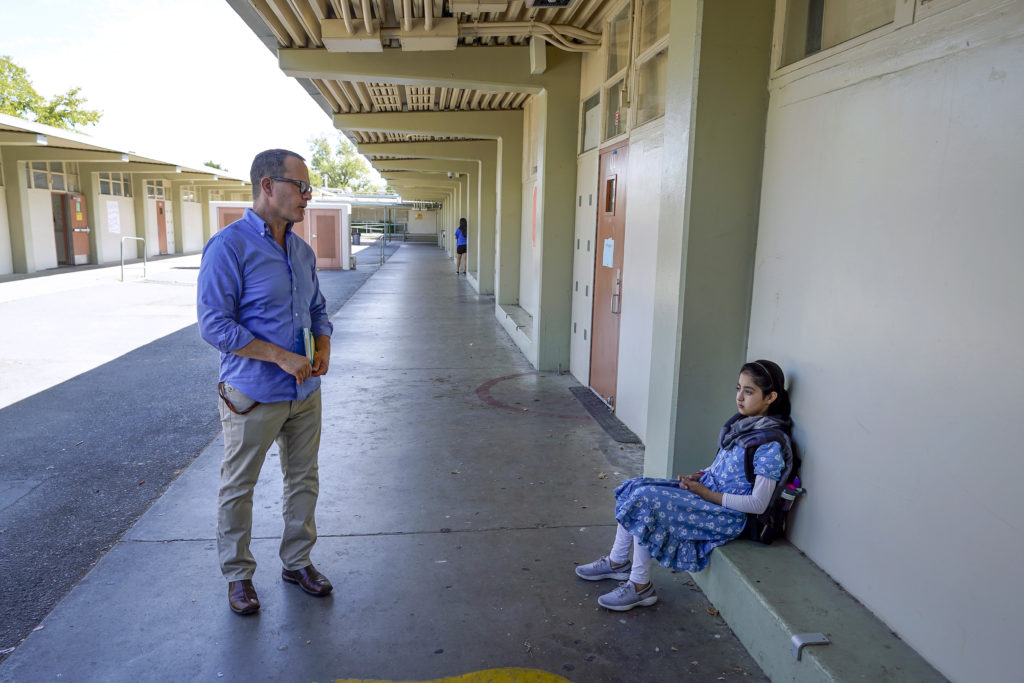
“There are so many kids that could go all day without any meaningful interaction with adults. The whole staff is focused on the kids and helping each other,” says Roth, coordinator for community schools at Encina High and member of San Juan Teachers Association (SJTA). “To work here, you have to be willing to love these kids as if they’re your own, because that’s what they deserve.”
Encina High is a trauma-informed school, which means that its staff, students and community are focused on recognizing and responding to the impacts of traumatic stress on students and staff. Trauma-informed schools show empathy to students, resist punitive responses, and provide support to manage traumatic stress and build a positive culture. Having embraced the trauma-informed approach for a decade now, Encina High has put a lot of effort into creating a culture of compassion, but it is still a work in progress, Roth says.
“Our job as educators is to do everything we can to help our students succeed. It might be a little optimistic to say we are there, which hurts to say. But all of the leaders are on board that this is the right path.”
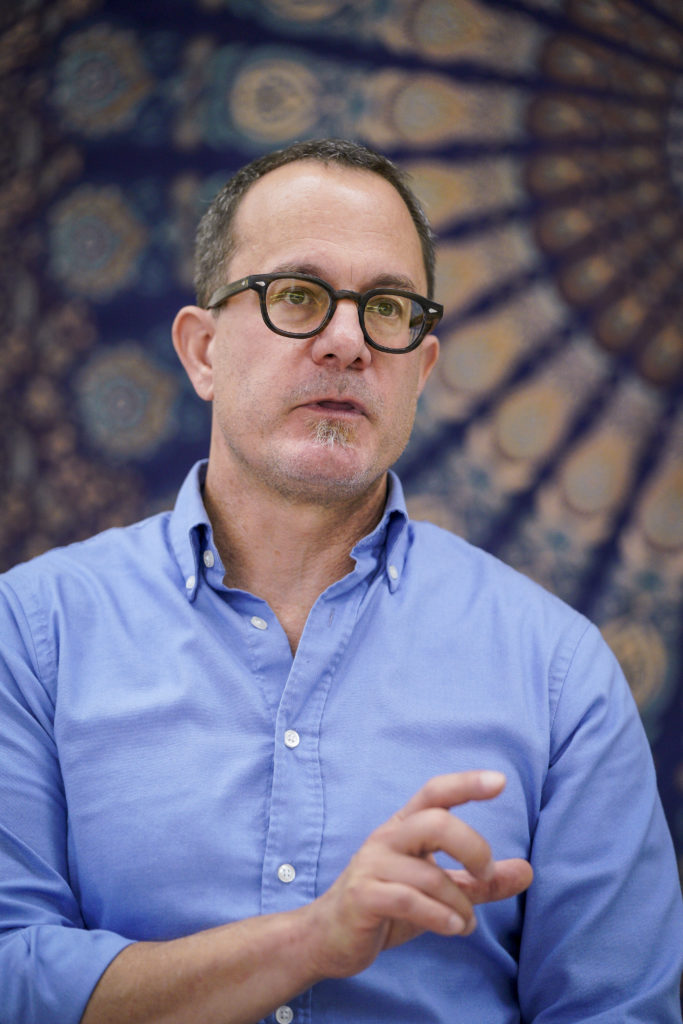
According to the National Child Traumatic Stress Network (NCTSN), one in four school-age children has been exposed to a traumatic event that can affect their learning and behavior. The research shows that adverse childhood experiences can cause physical and emotional distress in children, impairing learning and impacting school performance. These experiences include being subjected to or witnessing violence or abuse, accidents and natural disasters, bullying, having close relatives incarcerated, witnessing police activity or community violence, and living in chronically chaotic environments where housing and financial resources are not consistently available.
At Encina, where 98 percent of students qualify for free or reduced-price lunch, the likelihood is high that a substantial number are impacted by these and other traumatic experiences. That’s why trauma-informed practices like schoolwide meditation, a campus “wellness room,” wraparound services for students and their families, and restorative disciplinary practices are so important, Roth says.
“How do you support that kid who you hand out a test and he flips over a desk? Because he needs some help, not discipline,” Roth says. “How else can we combat the school-to-prison pipeline? It’s extra work, but our school believes in it so much.”
Special Report: Teaching Through Trauma
This is one of several stories that look at how educators are handling students with trauma. Read more:
Stories
- Teaching Students with Trauma: Practices that work
- A Culture of Compassion: What trauma-sensitive schools look like
- Phoenix Rising: Healing after natural disasters
- Crisis in Our Classrooms: Frightened, anxious immigrant students try to focus on education
- How COVID-19 Impacts the Undocumented
- Returning to Children’s Community Charter School in Paradise
- No Such Thing as a Bad Kid: Youth-care expert Charles D. Appelstein
- Taking Care of You, Too: Educator self-care is critical
- In Their Own Words: Helping students tell what they’ve lived
Resources
- How to help students after disaster
- Restorative practices that aid in trauma recovery
- Trauma Toolkit for Educators
- Helping our immigrant & undocumented students
- Know your rights with ICE
- Educator self-care tip sheet
- Defining trauma
- Symptoms of trauma
- Guidance from UC San Francisco’s HEARTS
Nurturing a community of trust
The giggling never quite stops as seventh and eighth graders try to maintain their balance on one leg with their hands together above their heads in the yoga tree pose. It’s physical education time at Jamestown Elementary School just after morning bell, but instead of tetherball and laps around a track, the activity is a circuit of yoga poses intended to give these students a little space before the day of learning starts.
“We like to start them off in the morning in a positive place. We can’t control what happened at home, but we can control how we start here,” says Jamestown teacher Michelle Bennett, explaining that the school day is crafted with a trauma-informed lens. “We looked at what these kids need, and we built the schedule to best support them.”

It is part of Jamestown School District’s mission to be a trauma-sensitive school system (the small district also includes a 30-student school in nearby Chinese Camp). With about 350 K-8 students in rural Gold Country, Jamestown Elementary has cultivated a community of support and trust that has been rooted in trauma-informed practices for a decade. Now, the collaborative focus of every adult at the school is trained on the well-being and safety of their students and “post-traumatic growth.”
“It was a big paradigm shift at the beginning. We just took bite-size pieces until it was part of who we are. It takes years to build a culture,” says third and fourth grade teacher Melissa Miotti, a member of Jamestown Teachers Association (JTA). “It’s all about the connections with the kids, because if we don’t have connections, we can’t work together. Helping students means supporting them in all aspects of their lives.”
Trauma-informed practices are so important to the Jamestown community, they’re included in the district’s Local Control and Accountability Plan (LCAP). All educators and education support professionals are provided with trauma-informed professional development. Additionally, the district’s family resource center provides wraparound services to the Jamestown community, including a recent series of family engagement events funded in part by a grant from CTA’s Institute for Teaching. District Superintendent Tessa Pelfrey says being a trauma-informed school is not a destination, but a constant effort to best support their students and each other.

“You have to begin with the why. Everyone needs to know why you’re taking a trauma-informed approach,” says Pelfrey, previously a Jamestown classroom teacher for 21 years. “That’s how you create a cohesive strategy focused on a safe, respectful learning community.”
Their mission accelerated four years ago when Mark Dyken, director of the Jamestown Family Resource Center, took a team of educators including Bennett and Miotti to a conference in Los Angeles on trauma-informed practices. Serving a community where 20 percent of families live below the poverty line, 76 percent qualify for free or reduced-price lunch, and a staggering 20 percent are homeless, the Jamestown team was ready to change the way they worked with their students.
“We needed to change the lens so it’s not ‘What’s wrong with this child?’ but ‘What happened to this child?’ As we’ve come to understand, the vast majority of these behaviors have some trauma behind them,” Dyken says, emphasizing that this trauma includes the poverty that affects one-fourth of all children in California. “Poverty charges interest. It compounds daily on itself, and it only gets worse. The way we deal with that cost is to address the source of it, which I believe is trauma.”
Many ways to help
“Does anyone have a question for Felix?” asks sixth grade teacher Adrian Nickols, prompting numerous hands to rise.
“Do you still play football?” Rigo asks his classmate.
“No, because we had to drive to San Jose to play and it was too far,” Felix responds.
“I didn’t know that about you, so I really like that you shared this,” Nickols tells Felix, who smiles. “It’s always fascinating to learn about our classmates.”

The morning meeting in Nickols’ class sets the tone for the day and allows students to connect with each other, Nickols and the school. This helps build a community of respect, where students feel safe and supported.
There are many ways to be trauma-sensitive, and Jamestown classrooms are filled with different practices meant to lower students’ stress and anxiety, as well as help them learn the skills to do it on their own. Miotti’s classroom has a “Peace Corner” — a small area, screened off from the rest of the class, containing manipulatives, a glitter jar, books and a timer — available for any student who needs a couple of minutes to themself. She uses color-based emotional scaling to teach her students to be aware of their feelings, how to identify when they don’t feel quite right, and what they can do to get back to a place where they feel ready to learn.
“They know they’re not in trouble for how they’re feeling,” Miotti says. “I try to model it while I teach, too, by telling them when I’m feeling a bit off.”
In addition to environmental trauma-informed practices, like using dimmers to soften harsh classroom lights and essential oils to freshen classroom atmospheres, Jamestown takes a deliberately restorative approach when it comes to student behavior and discipline. The school’s former detention room is now the “Reflection Room,” stocked with pages to color, books to read, timers and quiet corners with beanbags. There is even an empty cabinet for students who have experienced security-related trauma to hide in and feel safe. Any student can ask to go to the Reflection Room or walk the labyrinth painted on the blacktop just outside when they feel particularly frustrated or need some space.
The restorative approach to discipline means less punitive measures to change unwanted behaviors and more time spent understanding why these behaviors are occurring.
“We don’t send kids to the office anymore. That just doesn’t happen,” says Bennett, also a JTA member. “We’re building trust and relationships. We want them to know we are here for them and they can go to adults when they need help.”
Restorative approaches to discipline engage students in repairing situations and relationships harmed by their behavior, showing them that they are valued members of the school community. The first year that Jamestown implemented the restorative practices, suspensions dropped more than 40 percent.
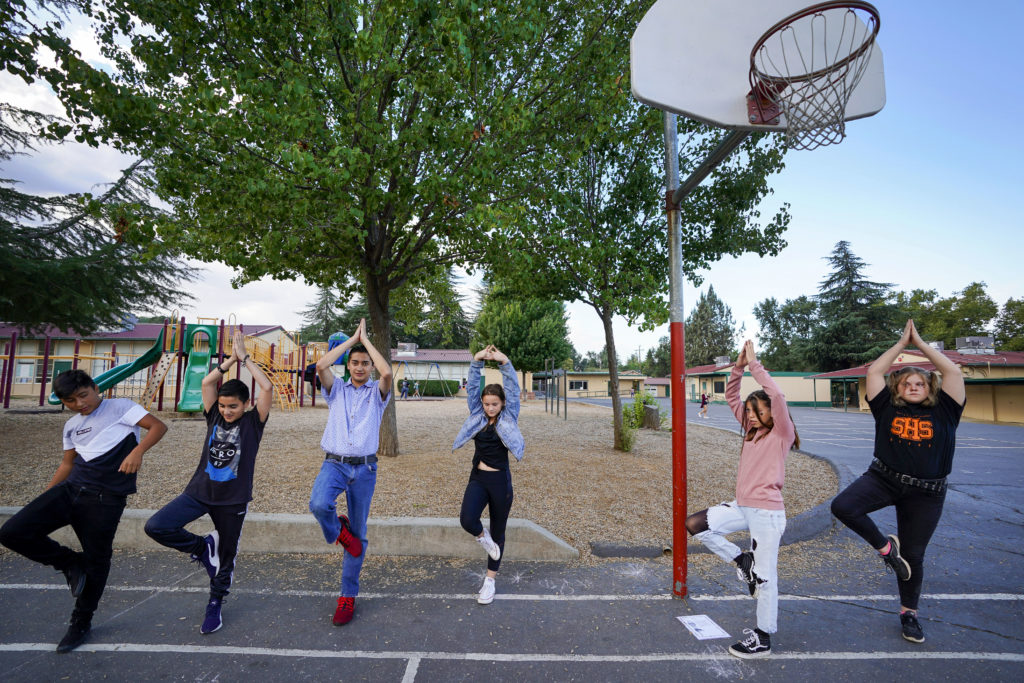
“You’re valuing the kids,” says teacher Greg Haney, president of JTA. “If they’re not in class, they’re not learning.”
This restorative approach played out during an incident that would traditionally mean an immediate referral to the principal’s office and likely out-of-classroom discipline, when a student admitted to urinating in the restroom sink. The student was escorted to custodian Jim Kasper, who engaged the boy about what happened and why before asking him to make amends by donning rubber gloves to clean the sink. After some elbow grease to right his wrong and a heart-to-heart to talk about his choices, the boy returned to class to continue the day’s learning.
Bennett shared another story about Kasper, a member of the California School Employees Association (CSEA), that illustrates the culture of compassion at Jamestown. One of Bennett’s students became particularly anxious about homework, so she asked him to take a moment outside and practice some breathing exercises while she got the class working on an assignment. When she came outside to help him, Bennett learned that Kasper had encountered the distraught boy and taken him to the office for assistance.
“Our custodian took care of this kid. Not me. Not a teacher,” Bennett says. “This is how it is supposed to be — that any adult on campus can see a student in need and get them help.”
The calming power of mindfulness
Encina High teacher Mary Reardon Hackman welcomes every student by name and with a smile at the door of her classroom. The students in her English language development class are returning from lunch, bringing with them an active but unfocused energy. Before they take a planned reading test, Reardon Hackman asks the class to practice a short mindfulness session to create some space between outside and the rest of the school day.
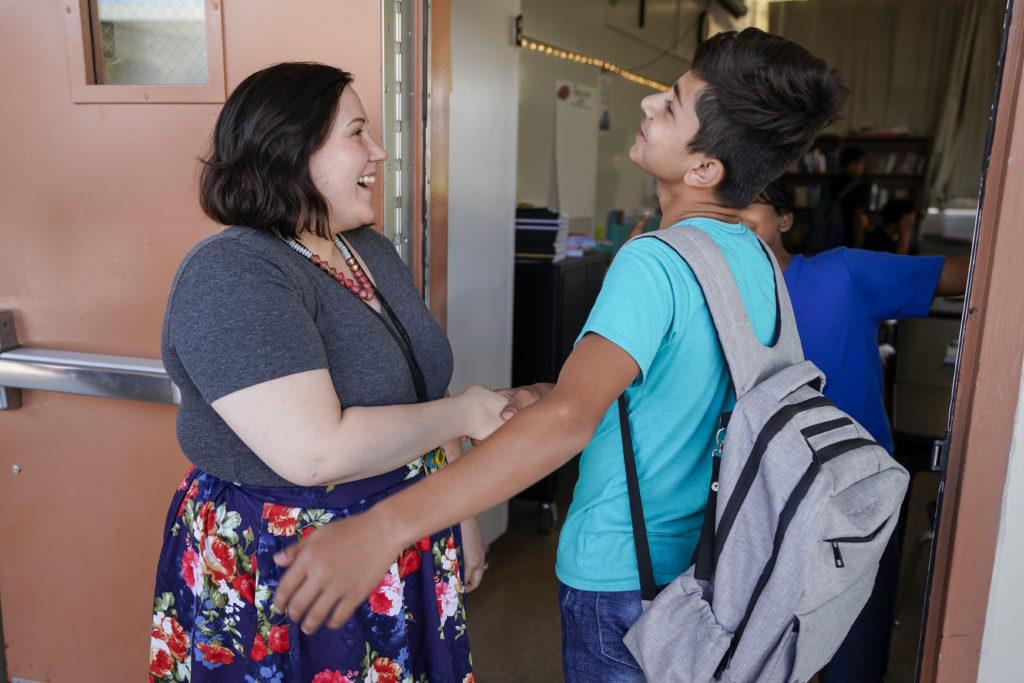
“So we’re going to do some breathing exercises before we do well on our test,” she says, bringing the room to a peaceful silence, broken only by her soft instructions. “Breathe in through your nose, deeply and slowly. Out through your mouth. Stretch your arms up and try to touch the ceiling. Reach high, as if you could touch the sky.”
After five minutes of deliberate breathing and stretching, the atmosphere feels different. Reardon Hackman, a member of SJTA, asks her students to raise their hands if they feel calmer, prompting nearly the entire class to thrust them into the air.
“It feels amazing,” exclaims Yasir Salarzai. “This is why we’re studying so well!”
“It makes me feel normal and ready to learn,” says Julian Castro.
“Now that I’m relaxed, I’m ready for the test,” says Hasina Shams.
Likely the most well-known of trauma-informed practices, the extensive research on mindfulness shows that it decreases stress and anxiety, increases attention, improves interpersonal relationships, and strengthens compassion, along with a wealth of other benefits. Mindfulness literally changes the brain, decreasing activity in the amygdala, which is related to fear and difficult emotions, and increasing activity in the hippocampus and prefrontal cortex, both of which help the body regulate emotions and behaviors.
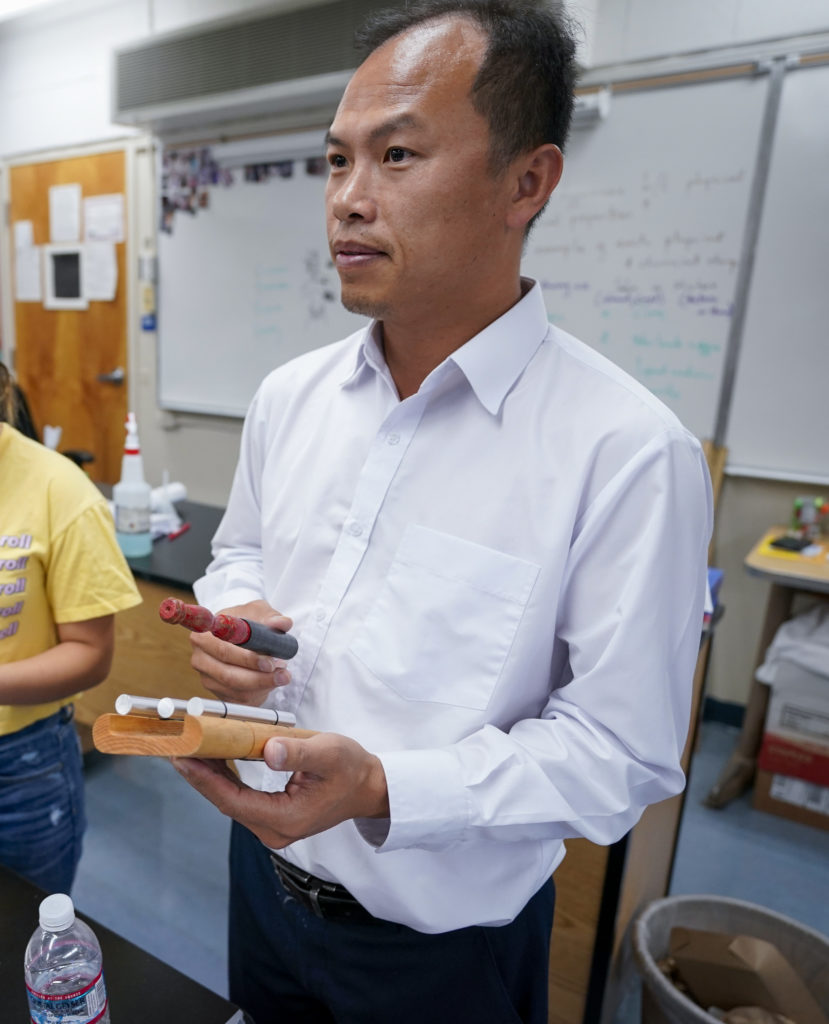
At Sacramento’s Mira Loma High School, teacher Phe Bach utilizes mindfulness in his chemistry class to help control emotions and focus attention, discussing the neuroscience behind the practice with his students. He also hosts a weekly mindfulness lunch, open to all, providing a space and guidance to help students “let their emotions be guests that come and go naturally.”
“When Mr. Bach first started his mindful lunch group every Tuesday, not only did I receive guidance on how to become mindful, I also realized that worrying about what I got on my last precalculus test was not only the antithesis of mindfulness, it was a waste of my time and energy,” student Aditya Rajavelu writes.
A presenter with CTA/Stanford’s Instructional Leadership Corps, Bach teaches fellow educators in San Juan Unified and beyond how to bring mindfulness to their classrooms and lives — and he is quick to note that the practice is as much for him as it is for the students.
“To practice mindfulness, you have to take care of yourself first. If it weren’t for mindfulness, I wouldn’t still be in teaching. Before, I stressed out a lot, but now I haven’t written a referral in years,” says Bach, a member of SJTA. “If you want to teach trauma-informed, you have to live it. You cannot give anything you don’t have.”
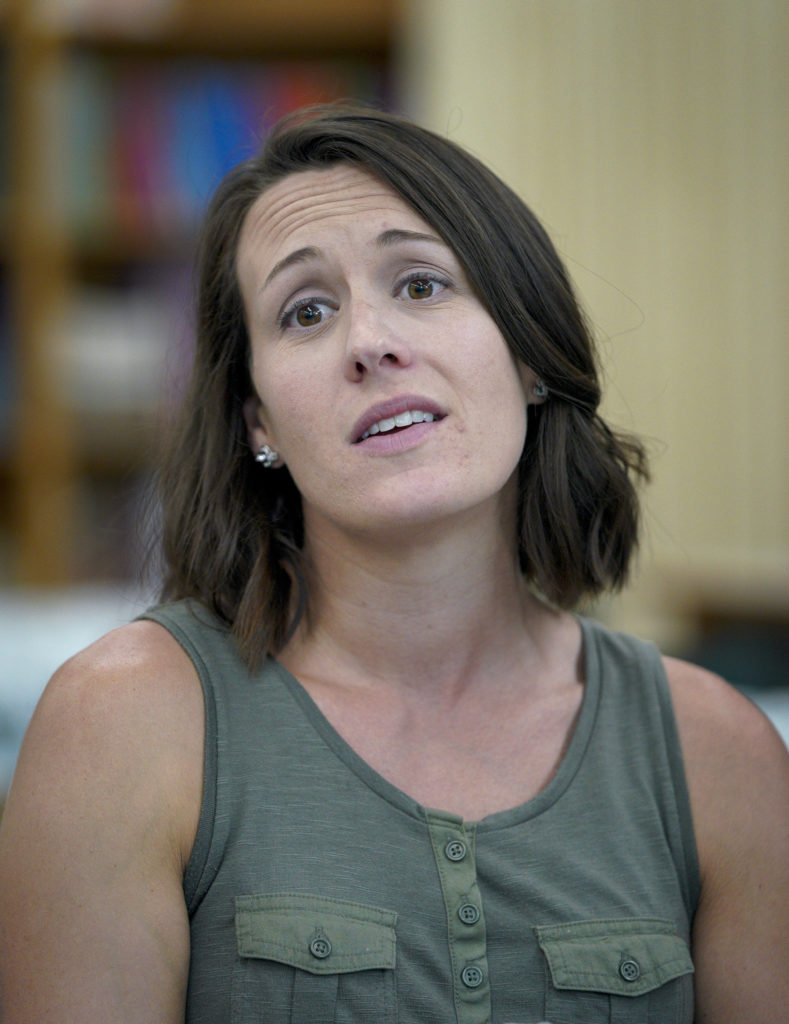
While it might seem that all the focus is on the needs of students, self-care for educators is an integral piece of the success of any trauma-sensitive school. Educators who work directly with traumatized children are particularly vulnerable to secondary traumatic stress, or compassion fatigue, which can cause educators to feel worn out or overwhelmed by students’ traumas.
“Self-care is an obligation for people who work with traumatized people or kids,” says Dyken. “We have to teach them by example and show them it’s really important to take care of ourselves.”
Self-care can take many forms, including going to a peaceful place on campus to relax for a moment. In Jamestown, Miotti, Bennett and Justine Jordet, a behavior and attendance support assistant and CSEA member, created such a place this summer when they gave the teachers’ lounge a serene makeover. What was previously just a drab break room is now a colorful, restful haven for educators to grab a quiet bite or sit on the couch with a cup of coffee. JTA keeps the lounge stocked with snacks and refreshments.
“It’s a safe space — a place where you can come and just be,” Miotti says. “We have to take care of each other. We need self-care to help our students deal with their trauma.”
– – – – – –
This story is part of our series that looks at how educators are handling students with trauma.
What Is a Trauma-Informed School System?
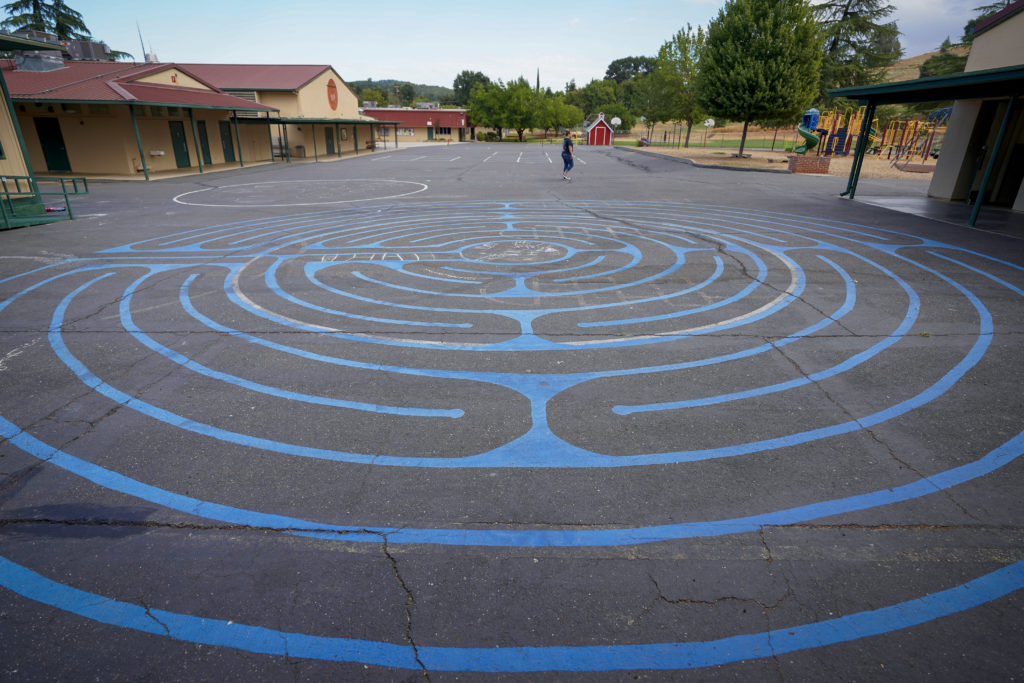
In trauma-informed schools, all educators, school staff, administrators, students, families and community members recognize and respond to the behavioral, emotional, relational and academic impact of traumatic stress on those within the school system.
These schools address impacts of trauma exposure on students and educators directly, resist punitive responses, and provide practical skills and support to manage traumatic stress reactions. Ways to integrate trauma-informed approaches into schools include strategic planning, professional development, direct intervention with traumatized students, and building knowledge and communication focused on creating and supporting environments that best enhance educational achievement.
The 10 core areas:
- Identifying and assessing traumatic stress
- Addressing and treating traumatic stress
- Teaching trauma education and awareness
- Having partnerships with students and families
- Creating a trauma-informed learning environment (social-emotional skills and wellness)
- Being culturally responsive
- Integrating emergency management and crisis response
- Understanding and addressing staff self-care and secondary traumatic stress
- Evaluating and revising school discipline policies and practices
- Collaborating across systems and establishing community partnerships
Source: National Child Traumatic Stress Network
Bringing Trauma-Informed Practices to Your School
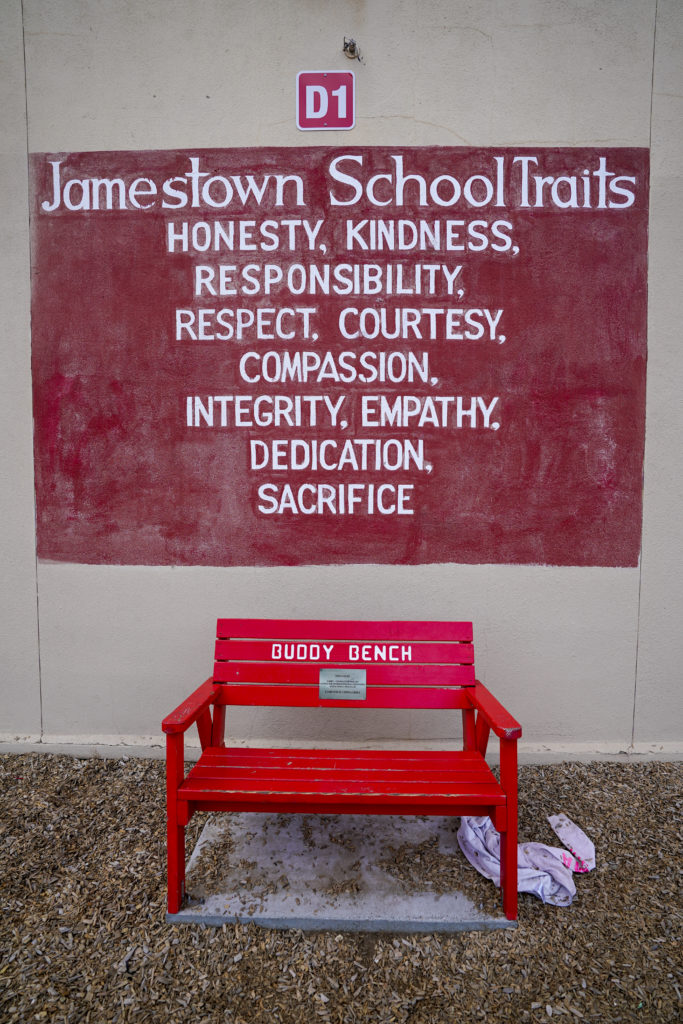
It takes a collaborative and deliberate effort to build a trauma-informed culture at school, but you don’t have to wait to start building empathetic and compassionate communities. We asked trauma-informed educators Barry Roth and Phe Bach for their advice to educators who want to bring these practices to their students.
Roth: “Begin working with people who are like-minded. You’re going to find colleagues who are doing trauma-informed practices on your site. Then go to the district and ask to have trauma-informed trainings added to your professional development. Start with the willing, work with your site leadership, your district admin, your local association and other educators to focus your efforts on the kids.”
Bach: “Some schools have a culture of fear, so it’s very important for us to cultivate compassion and kindness in our classrooms. Ask your fellow teachers about professional development opportunities to learn more about mindfulness and other trauma-informed practices. Give yourself an opportunity to experience it yourself. Take the initiative to bring this lens to your school.”
For more resources, visit the National Child Traumatic Stress Network, nctsn.org.
The Discussion 0 comments Post a Comment